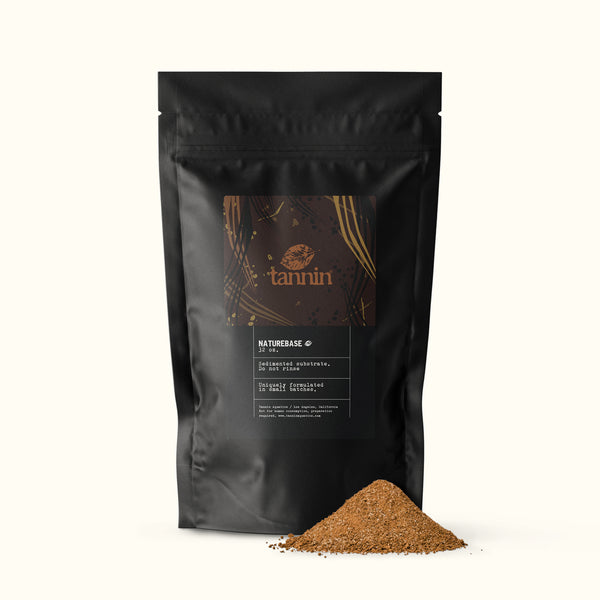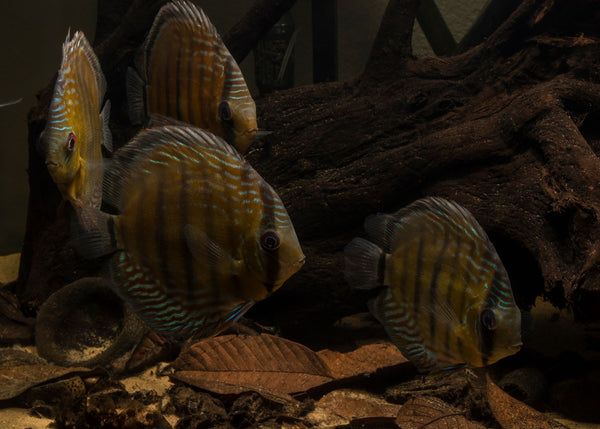- Continue Shopping
- Your Cart is Empty
Hard. Alkaline. Tinted. Possible.
As you know, the idea of a "tinted" aquarium has really caught one in the hobby. Hobbyists aren't quite as afraid as they used to be about having some color in their tanks! Tinted water is a "collateral benefit" to using botanicals and specialized substrates in our aquariums.
It's not "the whole story."

And of course, there's the whole "blackwater" thing.
Now, "blackwater" aquariums are arguably a sort of speciality of the "botanical-style" aquarium. Blackwater is known to ecologists to possess a specific set of environmental parameters and characteristics, which we've discussed many times before on these pages.
The hobby has somehow latched on to the most superficial aspect of blackwater- the look- and in the social media landscape, the appearance of blackwater has led to a tremendous confusion about what it actually is.

I want to believe that the tremendous explosion of interest in blackwater, and in botanical-style aquariums, has helped expose and expel some of these misconceptions. Sadly, there is still a ton of confusion, misconception, and just plain bad ideas, coupled with misinformation floating around out there.

There is enough blame go around- hobbyists, vendors, authors, all often tend to only look at the most superficial aspects, or to regurgitate what's found in the hobby literature. We need to do better, dig deeper. READ. We can't be simply impressed by the cool pictures and use that as the sole basis for our work. We need to educate ourselves.

If you look at the waters where many tropical fishes come from, one consistent theme is that the color or general appearance of the water generally has little to know bearing as to the pH. There are many hard, alkaline rivers, streams, and pools in the tropical habitats of the world which have a slight tint to them. The "tint" is caused by soils and the surrounding geography. Materials like wood and leaves also contribute to this tint, but their influence on the water chemistry is far more limited in many of these habitats.
In flooded forests, soil is the primary influence, and the leaves may play more of a biological role than a inorganic chemical role.

In the Orinoco in South America, you have blackwater and "white water" areas. The "white water" habitats, although not deeply tinted, nor crystal clear, are often a bit turbid. The seasonal turbidity of these “white waters” can be significant, and can actually help support some benthic algal growth.
These "white waters" contain large amounts of dissolved and suspended solids, which are produced by weathering of the soils and rocks high in the Andes. This rapid "weathering" produces the seasonal turbidity we're talking about here. Examples of "white water" rivers would be the main course of the Amazon, as well as the Japura and Jurua rivers.

By contrast, black waters flow primarily through the Guayana Shield, which has been weathered so extensively over the eons that it contributes only small amounts of suspended and dissolved solids into the water. We've talked about this many times before.
More confusing (or interesting, actually): Because it receives both whitewater and blackwater tributaries, the Orinoco is a mixture of water types with of strongly contrasting physical, chemical, and biological characteristics. A most interesting mix!
In blackwater systems, the geography and soil characteristics are the major contributors to the water chemistry, and often the color of the water. The leaves and such still contribute to the color of the water, but typically less to the environmental chemistry.

So, the big takeaway from all of this?
You can have hard, neutral to alkaline water, add leaves, twigs, etc., and keep all sorts of hard-water loving fishes and be quite faithful to the natural habitats. Yeah, even fishes like guppies and other livebearers. The color has nothing to do with the pH.

Remember, too, that leaves and other botanicals cannot soften the water, as we've discussed numerous times here.
Water for aquarium use can only be softened through means like reverse osmosis/deionization. And, the impact of botanicals on pH in hard water is extremely limited, too.

Conversely, of course, you can have clear, soft, acidic water. Remember, it's mainly about soils and geology. Case in point, the Tapajos river..

In general, blackwaters originate from sandy soils. High concentrations of humic acids in the water are thought to occur in drainages with what scientists call "podzol" sandy soils. "Podzol" is a soil classification which describes an infertile acidic soil having an "ashlike" subsurface layer from which minerals have been leached. That last part is very interesting, and helps explain in part the absence of minerals in blackwater.
Also interesting to note is that fact that soluble humic acids are adsorbed by clay minerals in what are known as "oxisol" soils, resulting in clear waters."Oxisol" soils are often classified as "laterite" soils, which some who grow plants are familiar with, known for their richness in iron and aluminum oxides. I'm no chemist, or even a planted tank geek..but aren't those important elements for aquatic plants?
Yeah...I think they are.

Okay, so, you can toss leaves and twigs and seed pods into your hard, alkaline tap water snd likely have no impact on pH. SO, what if you WANT soft, acidic water (clear, tinted, or richly stained)?
Well...let's touch on that one more time.
If your goal is to manipulate the pH of your tap water to bring it from neutral or alkaline conditions to the acidic range, you need to make it "malleable." The easiest, most cost-effective way is to utilize water which has been deionized. This is based achieved with a reverse osmosis/deionization ("RO/DI") unit. The idea of deionization(AKA "demineralization") simply means that the removal of ions from the water has occurred. Ions are electrically charged atoms or molecules found in water that have either a net negative or positive charge.
Ions which have a positive charge are called "cations" and ions with a negative charge are known as "anions". Materials known as ion exchange resins are used to exchange unwanted cations and anions with hydrogen and hydroxyl, which form pure water (H20), which is not an ion.
Okay, head spinning yet? Some of the ions commonly found in tap water include stuff like Calcium (Ca++), Magnesium (Mg++), Iron (Fe+++), Manganese (Mn++), Sodium (Na+), and Hydrogen (H+). These are removed with cation resins. Substances which we classify as anions include compounds like Chlorides (Cl-), Carbonates (CO3--), Nitrates (NO3-), Sulfates (SO4--), and Silica (SiO2-), which-wait for it- are removed with anion resins.
Deionization is a precess in which source water (from your tap) is forced through a series of "ion exchange resins", which are small plastic beads that are composed of organic polymer chains which have charged "functional groups" formulated into the resin bead. Each "functional group" has either a fixed positive or negative charge. Different ions are attached to these types of resins with differing strengths. It's a fascinating process which I'm probably not doing the best job of explaining.
Of course, that's not the whole story behind water treatment for our aquairums. Deionization is usually combined with reverse osmosis. Reverse osmosis is a process which removes contaminants from tap water when pressure forces it through a semipermeable membrane. Typically, a prefilter removes sediment and chlorine from water before it forces water through a semipermeable membrane to remove dissolved solids.Water flows from the more concentrated side (which has more contaminants) of the RO membrane to the less concentrated side (which has fewer contaminants) to provide "product" water.

One your tap water has been treated in this manner, it's much easier to manipulate the pH through variety of means, including utilizing leaves, seed pods, and other botanical materials. It's the important first step towards creating "blackwater" in your aquarium.
Okay, whew! That's a lot of stuff to take on, right? And, me not being a chemist, I'm probably not doing the best job of explaining this stuff...
Suffice it to say, a combination reverse osmosis/deionization unit is a fundamental piece of equipment and great investment for your hobby. If you're serious about creating optimum conditions for your fishes, the first step is to incorporate RO/DI into your aquarium practice.
One more time on soils and their influence on water chemistry:
Soil geology is one of the most- if not THE MOST- profound influences on blackwater in natural aquatic systems. It plays a fundamental role in creating the chemical characteristics which are common to these ecosystems.

Don[t use highly buffering substrates if your goal is to keep your pH down. It's part of the reason why we formulated our "NatureBase" line to work with botanical-style tanks!

Okay, I could go on and on and babble and likely contort myself and end up making bad generalities of my own if I'm not too careful!
At the end of the day, please, please research. Please don't buy into the superficial generalities about the impact of leaves and botanicals on water chemistry, or the idea that you can't have tinted water in hard, alkaline conditions.
And of course, remember that creating a "blackwater aquarium" is far more complex than simply throwing in some botanicals, a bag of Rooibos, or even our "Shade" sachets, watching the water change color, and telling yourself that you did it!

We must always educate ourselves. Put in some research. We should want to! It's fun!
Successful aquarium keeping with any type of tank requires a fundamental understanding of basic stuff, like water chemistry biology, and ecology- and the basics of aquarium keeping. Stuff which, I'm sad to say, still seems to mystify or elude many hobbyists, who'd much rather look at cool pics of tanks on instagram, or consult a very simple infographic, rather than do a little basic research.
We all need to do our part to change this.
For the good of the hobby, our fishes, and each other.
Stay curious. Stay resourceful. Stay diligent. Stay thoughtful. Stay engaged...
And Stay Wet.
Scott Fellman
Tannin Aquatics








Scott Fellman
Author